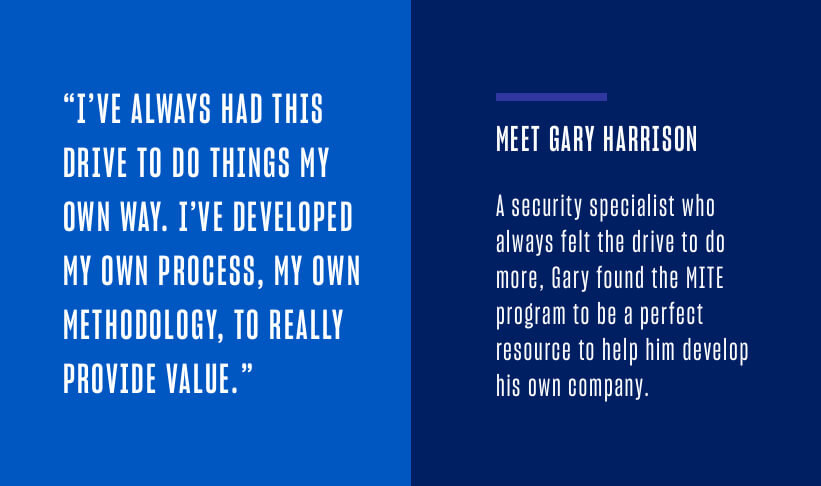Gary Harrison has never been one to wait for things to happen. You can see it in how he joined the U.S. Air Force straight out of high school and then immediately signed up for government contracting work with Booz Allen Hamilton. It’s the same reason his search for more experiences pushed him toward commercial consulting, which enabled him to do more traveling, and how he utilized his spare hours to round out his education with a degree in cybersecurity to reinforce his network and security skills.
It was during this professional development that Gary came to see that restlessness within himself. While he found that he greatly enjoyed the work of consulting — the identification of problems, constant ideation and effective problem solving — at the end of the day, he was missing something in solving immediate problems for individual clients.
“I feel I’ve always been entrepreneurially minded,” Gary reflects, “and more and more during my consulting, I realized I wanted to solve problems at scale. I’ve always had this drive to do things my own way. I’ve developed my own process, my own methodology, to really provide value. So the question became what was the next step in my career? I knew that I wanted to do my own things, to be more entrepreneurial, but I didn’t know how to do it.”
Finding the Right Step Forward
Part of the process of moving forward meant Gary had to determine what he didn’t want to do. “I didn’t want to go for another advanced cybersecurity degree,” he admits. “It felt like I had learned a lot, and while there is always more I could learn in that area, I just didn’t have the drive for it. So, I considered going for an MBA, but there’s a lot about an MBA degree that felt too corporate-minded to me. There was value there, but it didn’t really speak to me.”
“So I asked myself, ‘Are there any masters in entrepreneurship?’ And it was during that search that I saw the MITE program. What really spoke to me was that — not only was it entrepreneurial focused, it’s actually a semi-technical degree. It’s set up so there’s this balance of classes on business and classes on emerging technology like networking that would be critical for anyone who wants to be able to innovate at scale.”
“It was that ability, that promise, of being able to innovate at scale that brought me to the MITE program. It was an absolutely perfect fit because this is how I want to solve problems. It seemed like such an awesome opportunity because it would give me the tools I needed to achieve my goals.”
Being Part of the MITE Program
After being accepted, Gary became part of the first cohort of the MITE program. “What I found so cool about the program is that — it can be hard to articulate entrepreneurial concepts, but what MITE does really well is break down the important things. Such as, how not to design a product in search of a problem, but to identify a problem and then ideate your approach around that. That gave me the skills to conceptualize a product — or the solution to a problem — but also the technical know-how on how to get my hands dirty to physically solve a problem. How I like to define the MITE degree is ‘how to found a tech startup.’”
“How I like to define the MITE degree is ‘how to found a tech startup.’”
Aside from these insights into the entrepreneurial process, Gary appreciated the instruction on the more practical elements too. “The program pushes you to ask how you can validate an idea to know that’s something a client will really want. You do things like project out how much revenue you’re going to need for a year, or determine how much of an investment I need to get from Point A to Point Z.”
“Before the program, I read through some of the books we used in the course. But they don’t just throw a book at you and call it a day; they add practicality to it. One of the key points in the course is you’re literally going from an idea to structuring out what you need for a minimum viable product (MVP). It’s group work, but more of a realistic scenario where you’re acting as the founders of a company. [The instructors] encouraged us to actually reach out to real people, to use our status as students to leverage help from other networks, be they LinkedIn or whatever. That practicality really connected the dots for me — it helped make what was in the book more real.”
Aside from the course material itself, Gary found more of the support and experiences he was looking for with his fellow students and faculty. “I’m a San Diego native and, even though the school is physically local to me — and the campus is beautiful — what I really appreciate is the job USD has done in marketing its online program for a global audience. One of the people I was working with throughout my time in the program was actually from DC, and another student was from Africa. It was a great opportunity to meet new people and exchange ideas.
“I found that USD really does a good job of building community. Not only is there an internal social network for students and alum, but the professors are extremely approachable. Many times they’d email us after a course. They’d say something like, ‘Hey, I’d love to keep in touch, and if you need any help on your ideas in building your business, I want to be a resource for you. I’m here to help, even outside of the classroom.’ That level of engagement really set the program apart for me. It was so helpful, it really felt like they genuinely wanted us to succeed.”
“That level of engagement really set the program apart for me. It was so helpful, it really felt like they genuinely wanted us to succeed.”
Turning Theory Into Practice, and Obstacles Into Opportunities
Part of the joy of opening yourself to new experiences is learning how to deal with the unexpected — a challenge that Gary faced while finishing the MITE program. “When I first started the program, I had an eighteen-month plan. I figured I’d continue working my current job and then when I finished, I’d figure out how to jump into my business. At the time, I had ended up working for a tech company — one that didn’t make it through the most recent tech downturn. So for the first time since high school, I found myself without a job.”
“Fortunately, I was almost done with the program and saw it as a silver lining. What MITE really provided me was this approach where, rather than the mindset of ‘hey, I’m going to do a service,’ it led me to ask questions about how I could identify my client’s problems and then how I could solve them at scale. That approach to scalability was something I started weaving into my business plan. What I learned in the cohort has led me to the point where I can ask the right questions of my clients to get at the real problems they need solved.”
“My plan was to take the concepts I learned, such as budgeting out and developing MVPs and applying them to the insights I could develop to better address cybersecurity problems at scale. After graduation, I still had questions on the business development side, so I reached out to [MITE Program Directory] Jeff Teza to ask him for his advice on different things. And he carved out some time, we went and got coffee and actually met and talked a couple of times. That he was willing to offer me that one-on-one advice was really awesome.”
This past year, Gary founded his cybersecurity consulting company Radiant Security. It’s early days yet, but Gary already has ideas on where he wants to go. “I have a lot of process know-how, experience and success in automating the major pain points. I see automation as a key means of helping companies scale their security, as it’s something that hasn’t really been solved yet. There are so many threats out there, analysts are getting burned out and stuff inevitably gets through the cracks.”
“I want to build a co-managed security operations platform that combines automation and process to help teams scale in a way that simple products can’t really do. I see this approach to product and process as a holistic means of addressing my client’s security concerns. To get there, I’m looking at developing a managed product using what I learned in MITE, keeping the [development] process simple and building out from there.”
His Advice for Future and Prospective Students
When asked about his advice for others, Gary offers a few suggestions.
If you’re going into the MITE program, he recommends making the effort to get organized, take notes and save links. “There are so many good resources you’re given in the program,” he explains. “One of the first things I did was set up a dedicated bookmark folder. You’re given links to YouTube videos, journal articles and a lot of bespoke resources. There’s a lot of gold in there that I know I’ll be referencing for years to come. Having those resources is easily worth the time for those taking the program.”
As for those thinking about looking into the MITE program, Gary recommends taking a look inward. “What is your passion? What’s driving you? What makes you want to solve problems? If you’re like me and you want to solve problems, if you’re always looking at the world as it could be, then I think this is the perfect program.”
“It’s a very hands-on course of study. You don’t have to come in with a specific idea, but if you know where your passions are, then you’ll have more of a true idea of what you want at the end of the program. I didn’t know what I wanted to do with Radiant when I started the program, but MITE helped me to hone my idea, to ensure that I could realize it more quickly than if I hadn’t taken the program.”



